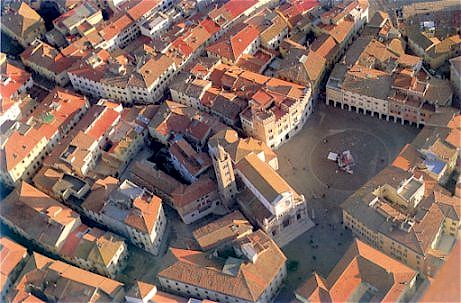

|
Grosseto lies on the Tuscan coast of the area known as the Maremma. Although the name Maremma is most commonly associated with the vast, formerly marshy, coastal area made fit for habitation only during the past couple of hundred years, the Maremma is in fact a large and diverse area covering parts of southwestern Tuscany and some of northern Latium. The Alta Maremma is the northern part, from Grosseto northwards to Cecina River just south of Livorno. The inland areas are high above the coastal plains and provide spectacular views from the hill top towns located there. The Alta Maremma is thickly wooded towards Siena (for example around Pari and Torniella) and somewhat rockier towards Roccatederighi where the steep descent to the coastal plains begins. |
|
|
Grosseto
itself is a relatively recent city that developed
during the mediaeval period on a site where Etruscan boats used to pass through the marshes. It provided accommodation for the workers in the salt
pans and developed slowly until eventually it was fortified by the Medici. It is the agricultural capital of the Maremma and is known for its
sun-ripened tomatoes, artichokes, mushrooms, spinach, olives and wild boar. Castiglione della PescaiaThe main attraction
nearby is Castiglione della Pescaia, a very attractive
town consisting of a fishing boat harbour dominated by a mediaeval castle. |
More about Castiglione della Pescaia
Grosseto from the Etruscans to modern timesGrosseto was one of the principal Etruscan cities, situated at the mouth of the Ombrone river, in the once unhealthy Maremma country. It was first mentioned in 803 as a fief of the Counts Aldobrandeschi. It grew in importance over the years with the decline of the Etruscan cities of Rusellæ and Vetulonia. The ruins of Rusellæ are about five miles from Grosseto, with cyclopean walls four miles in circumference and sulphur baths that were restored in the 19 C for medicinal purposes. Rusellæ also once had an amphitheatre and it was an episcopal See from the 5 C. St. Gregory the Great commended the inhabitants of Vetulonia to the spiritual care of Balbinus, Bishop of Rusellæ. In 1137, Grosseto was besieged by Henry of Bavaria, envoy to Lothair III, and in 1138 Innocent II transferred the See to Grosseto, and Rolando, Bishop of Rusellæ, became the Bishop of Grosseto. In 1224, the Siennese captured Grosseto and were legally invested with it by the imperial vicar and thus the fortunes of Grosseto parallelled those of Sienna. It became an important stronghold, and the fortress (rocca), the walls and bastions can still be seen. In 1266 and again in 1355, Grosseto attempted to liberate itself from Sienna but without success. Among the successors of Rolando were Fra Bartolommeo da Amelia (1278), employed by the popes on many legations, Angelo Pattaroli (1330), a famous Dominican, Cardinal Raffaele Petrucci (1497), a native of Sienna and Lord of that city, hated alike for his cupidity and his worldly lifestyle, Ferdinand Cardinal Ponzetti (1522), a learned man but fond of wealth and Marcantonio Campeggio (1528), who was distinguished at the Council of Trent. |
|
The building of a new line of walls by Francesco I de Medici in 1574, replacing those dating from the 12 -14 C, was part of his programme to make Grosseto a fortress protecting his southern border. The design was by Baldassarre Lanci and the construction was completed 19 years later, under Grand Duke Ferdinand I. Until 1757, the exterior part was surrounded by a moat with an earth rampart. There were two main gates: Porta Nuova, to the north, and Porta Reale (now Porta Vecchia), to the south. The walls are now used as public park and walk. Medicean walls of Grosseto Grosseto CathedralConstruction of the cathedral, the work of Sozo Rustichini of Sienna, was begun at the end of the 13 C on the site of the Parish Church of Santa Maria Assunta. It was completed in 1295 and restored in 1846. The façade consists of alternate layers of white and black marble. The campanile dates from 1402 (restored in 1911) and the splendidly carved baptismal font from 1470-1474. The façade appears to be Romanesque in style, but is almost entirely result of the 16 C and 1816-1855 restorations. Of the original structure, the cathedral retains decorative parts including the symbols of the Evangelists. The plan is a Latin cross, with transept and apse. The interior has a nave with two aisles, parted by cruciform pilasters. The main artworks are a Font and the Madonna delle Grazie by Matteo di Giovanni (1470). More about the Cathedral of Grosseto |
Roselle (Rusellæ)Roselle, now a dependency of Grosseto, was once the main city in the area. It was built by the Etruscans on a hill that offered protection and commanded all of the nearby valley. The extent of its dominion is not clear, but probably at its peak included the most of the territory of Vetulonia. The city's independence ended forever in 294 BC, when, according to Livy, it was conquered by the Romans. After the end of the Roman Empire, in the 5 C, Roselle was still the most important centre of the area of what is now southern Tuscany. Its gradual abandonment began in 1138, when the diocese seat was moved to Grosseto. |
Grosseto and the Maremma © ammonet InfoTech 2003 - 2024